While you might think transforming your living room into a relaxing oasis requires extensive renovation, the strategic placement of indoor plants can achieve the same effect at a fraction of the cost. You’ll discover how combining different plant heights, textures, and containers can create distinct atmospheres—from minimalist sanctuaries with single statement plants to lush urban jungles with layered greenery. Each of these ten carefully curated styles offers a unique approach to bringing natural serenity into your space.
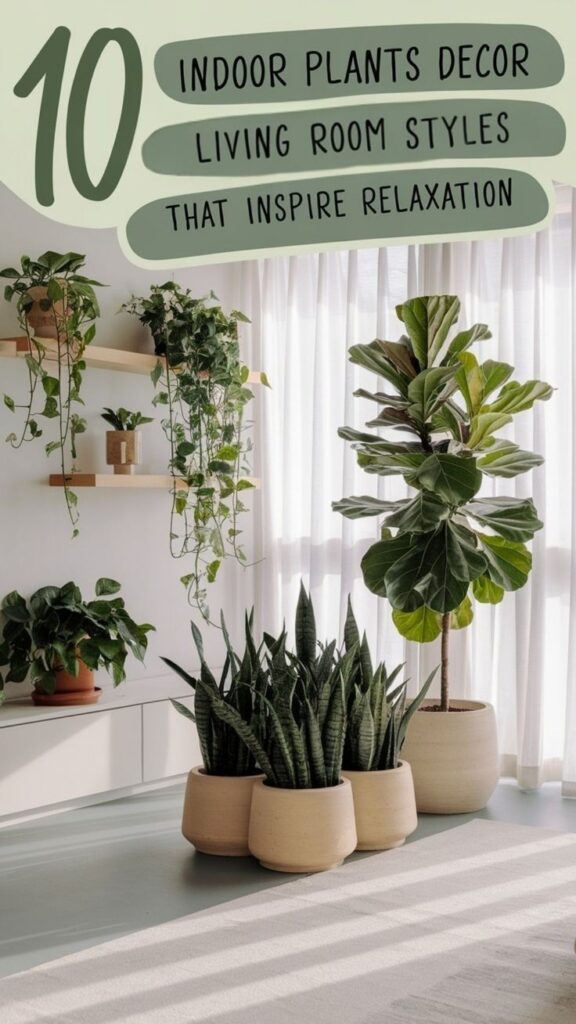
Contents
- 1 The Minimalist Oasis: Single Statement Plants
- 2 Bohemian Plant Paradise: Mixing Heights and Textures
- 3 Modern Tropical Retreat: Bold Leaves and Clean Lines
- 4 Vertical Garden Dreams: Wall-Mounted Plant Displays
- 5 Window-Side Sanctuary: Light-Loving Plant Arrangements
- 6 Sleek Scandinavian: White Pots and Green Accents
- 7 The Urban Jungle: Layered Plant Compositions
- 8 Japanese Zen Garden: Simple Plant Groupings
- 9 Mediterranean Warmth: Terra Cotta and Trailing Plants
- 10 Mid-Century Modern: Architectural Plants and Wood Tones
The Minimalist Oasis: Single Statement Plants
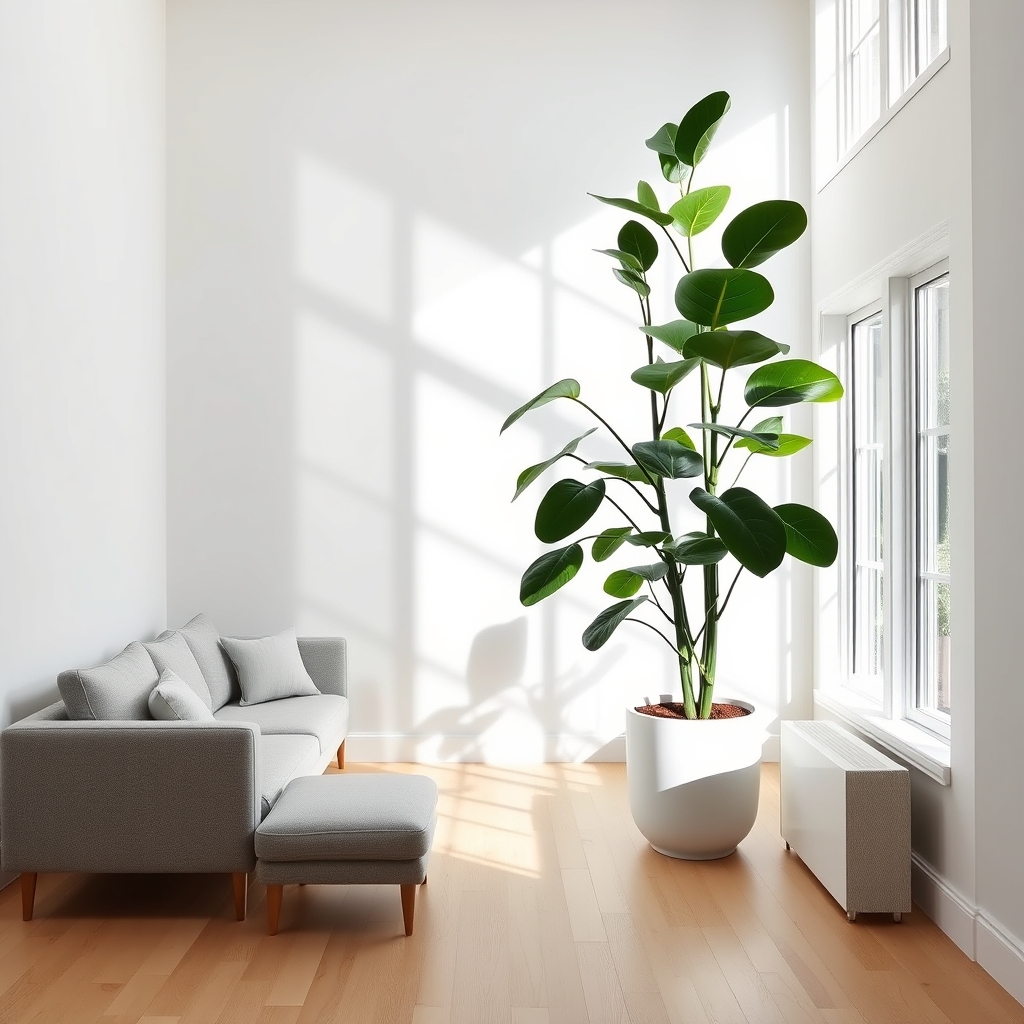
Large, solitary plants that command attention while maintaining clean, uncluttered aesthetics.
These specimens typically stand 4-6 feet tall and feature bold, architectural forms. Popular choices include the Fiddle Leaf Fig with its large violin-shaped leaves, the Snake Plant with its strong vertical lines, or the Bird of Paradise with its dramatic tropical foliage.
The plant is positioned as a focal point, often in a corner or beside furniture, in a simple, modern planter that complements the minimalist style.
This approach creates visual impact through simplicity, allowing a single spectacular plant to define the space rather than multiple smaller specimens.
Bohemian Plant Paradise: Mixing Heights and Textures
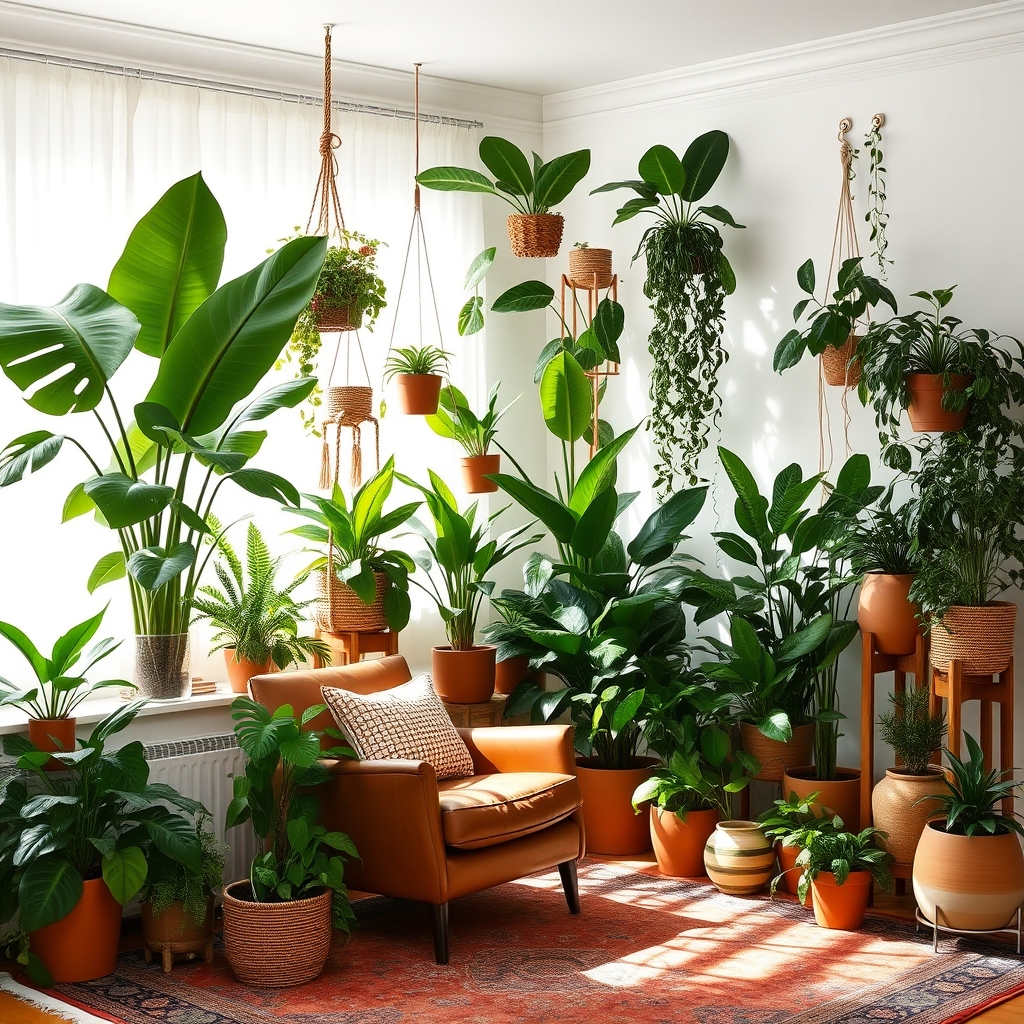
A Bohemian Plant Paradise creates a relaxed, eclectic atmosphere by combining plants of varying heights, textures, and growing habits.
Tall floor plants like Fiddle Leaf Figs or Bird of Paradise stand alongside cascading varieties such as String of Pearls and Pothos.
Plants are displayed at multiple levels using macramé hangers, floating shelves, and plant stands of different heights.
The aesthetic features a mix of pot styles – from woven baskets to ceramic planters in earth tones – complementing the free-spirited vibe.
Textural contrast comes from pairing smooth, broad leaves with feathery ferns and trailing vines, while mixing upright structural plants with spreading or drooping varieties adds visual interest and depth to the space.
Modern Tropical Retreat: Bold Leaves and Clean Lines
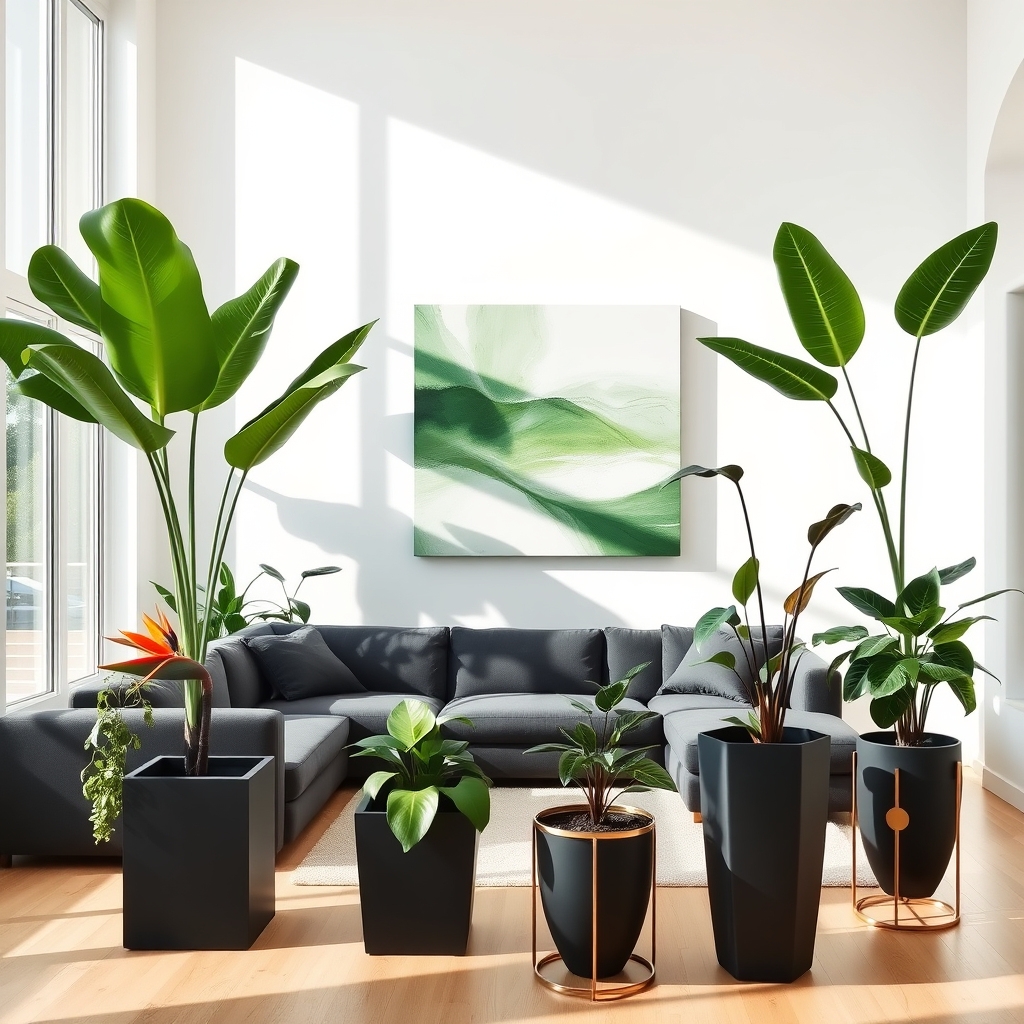
Modern Tropical Retreat: Bold Leaves and Clean Lines combines minimalist design principles with dramatic tropical foliage to create a sophisticated urban oasis.
Large-leafed plants like Monstera deliciosa and Bird of Paradise stand as striking focal points against white walls and sleek furniture. The style features geometric planters in matte black, white, or brushed metal finishes, often positioned at varying heights using modern plant stands.
Clean architectural lines of the room contrast with the organic shapes of palm fronds and split-leaf philodendrons, while clustering plants in deliberate groupings maintains an organized, contemporary feel.
This look particularly suits open-plan spaces with abundant natural light and high ceilings, where statement plants can reach their full dramatic potential without overwhelming the space.
Vertical Garden Dreams: Wall-Mounted Plant Displays
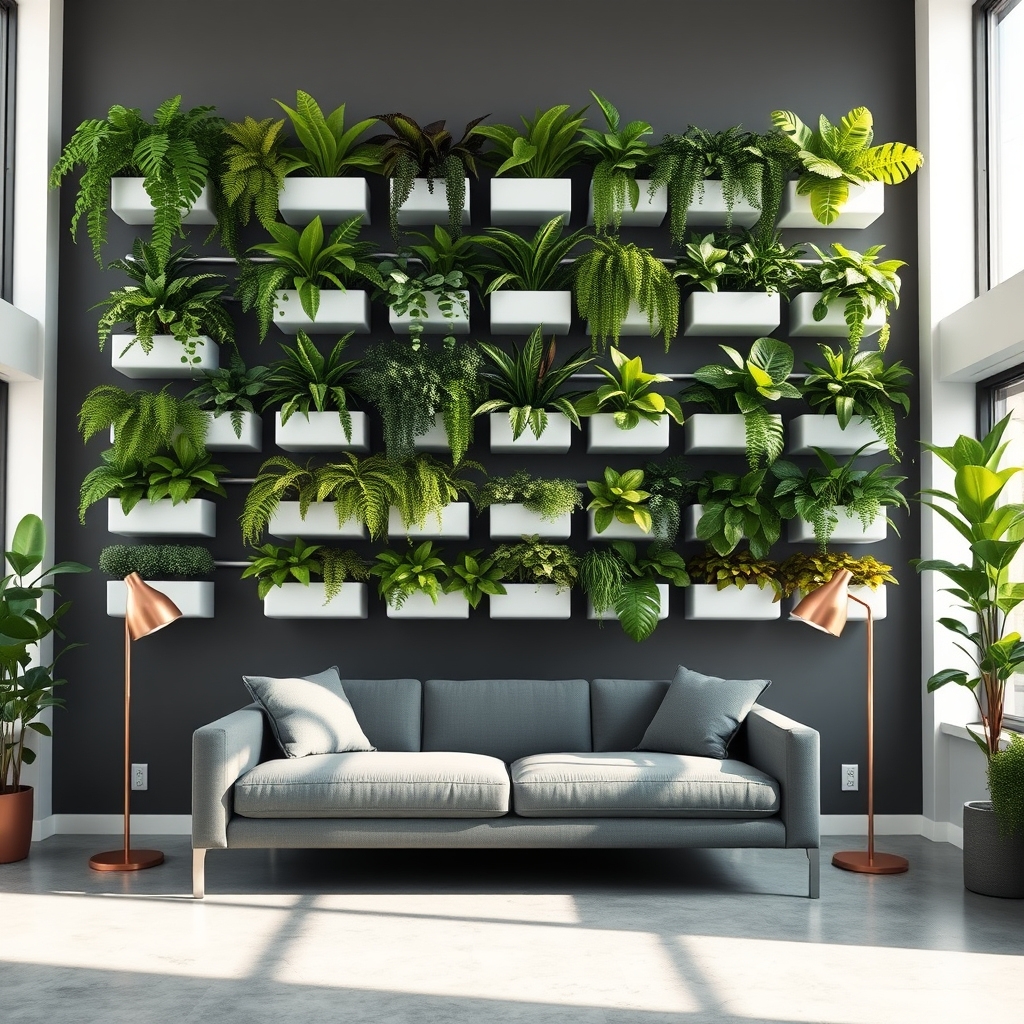
Vertical garden displays transform living room walls into lush, living tapestries by arranging plants in upward-growing configurations.
These space-saving installations typically feature multiple levels of plants mounted directly onto walls using specialized planters, pocket systems, or modular panels.
Plants cascade downward or grow upward, creating dynamic layers of foliage at different heights.
Common design elements include geometric patterns, mixed textures, and varying shades of green interspersed with flowering plants.
Wall-mounted gardens can incorporate both small and medium-sized plants, from trailing pothos and ferns to compact peace lilies and air plants, maximizing vertical space while adding natural beauty to interior walls.
Window-Side Sanctuary: Light-Loving Plant Arrangements
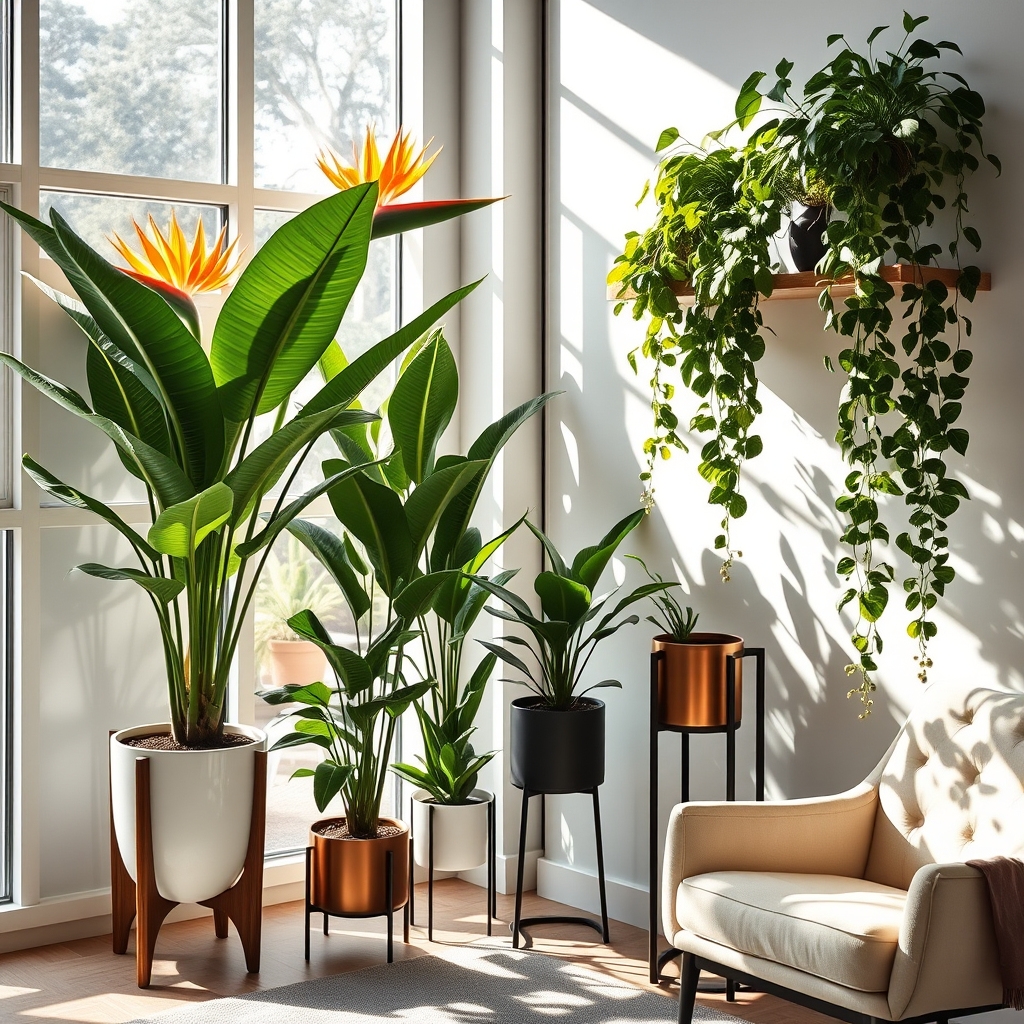
Window-Side Sanctuary: Light-Loving Plant Arrangements features a curated collection of sun-seeking plants positioned strategically near windows to create a natural, garden-like atmosphere indoors.
This arrangement typically includes tall, architectural plants like Bird of Paradise or Fiddle Leaf Fig as focal points, complemented by cascading plants such as Pothos or String of Pearls that can drape over shelving or plant stands at varying heights.
Plants are grouped based on similar light requirements, with sun-loving varieties placed closest to the window glass.
The setup often incorporates different pot sizes, shapes, and elevations to create visual interest, while maintaining enough space between plants to ensure proper air circulation and growth.
This arrangement transforms window areas into vibrant green spaces that maximize natural light exposure while serving as a living privacy screen.
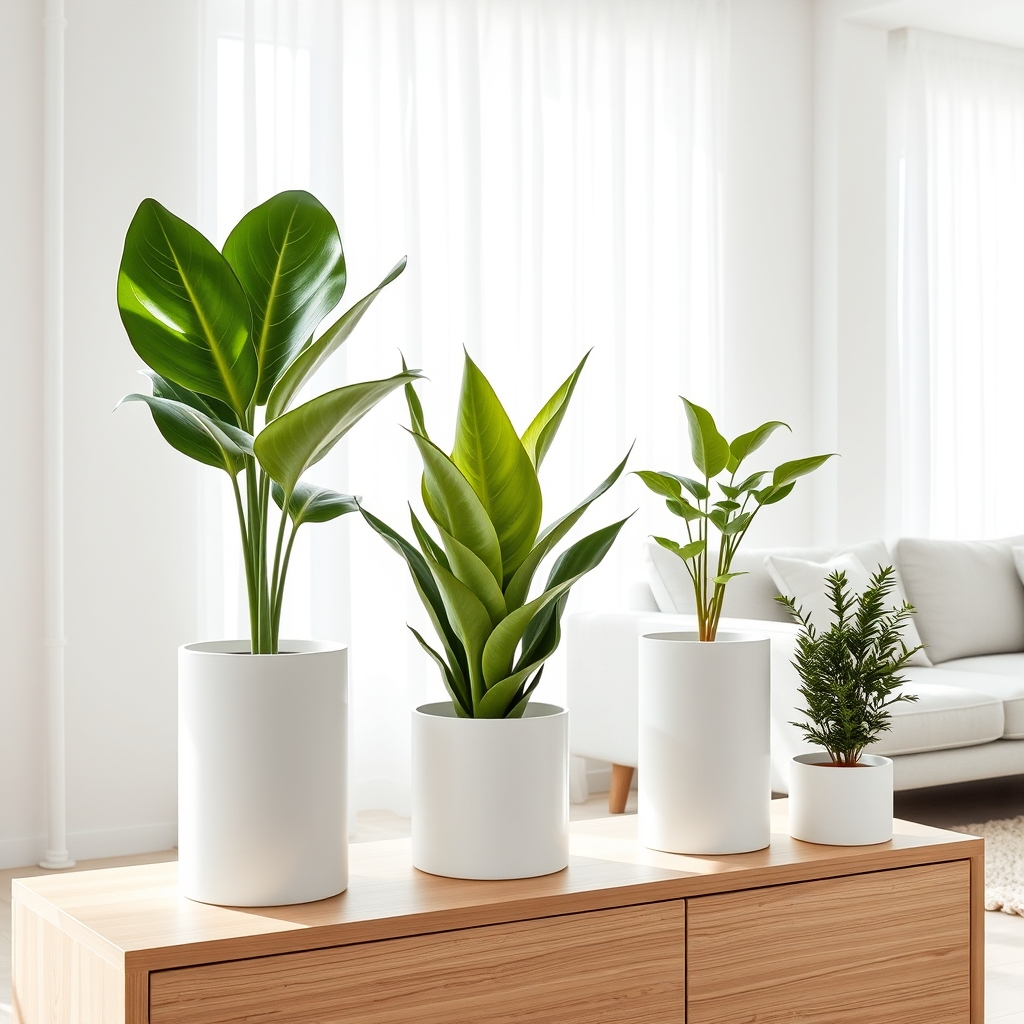
Sleek Scandinavian design pairs minimalist white ceramic pots with vibrant green plants, creating a clean, modern aesthetic. The style features smooth, cylindrical or geometric planters without ornate details, typically arranged in asymmetrical groupings at varying heights.
Snake plants, ZZ plants, and fiddle leaf figs complement this look with their strong architectural forms. White pots reflect light and brighten spaces while letting the plants’ natural green hues become striking focal points.
This understated approach embodies the Scandinavian principles of functionality and simplicity, with plants serving as organic elements that soften the room’s clean lines.
The Urban Jungle: Layered Plant Compositions
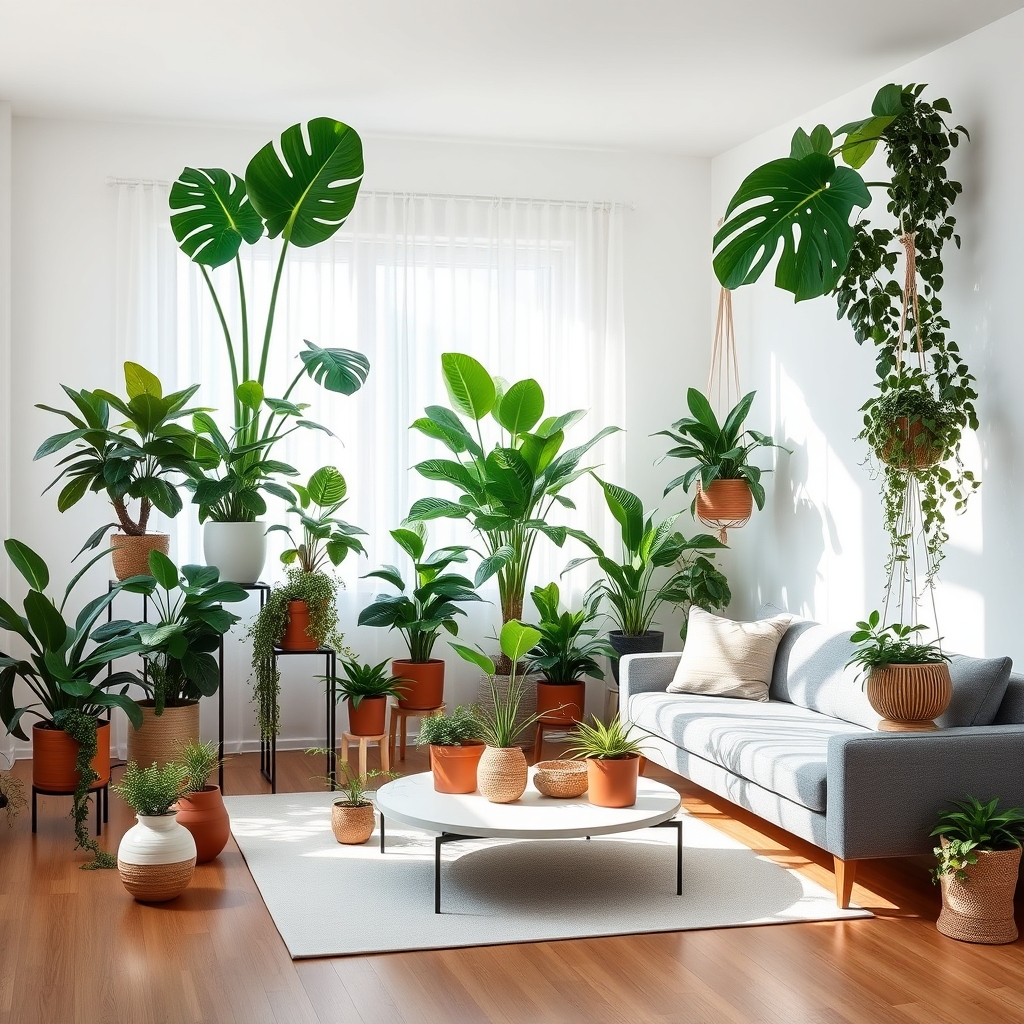
The Urban Jungle: Layered Plant Compositions creates a multi-dimensional, forest-like atmosphere within living spaces by arranging plants at varying heights and depths.
This design approach combines tall floor plants, medium-sized tabletop specimens, and hanging or climbing varieties to establish distinct vertical layers.
Plants are strategically positioned with larger specimens like monstera or fiddle leaf figs in the background, medium-sized plants like pothos or philodendrons at mid-level, and smaller plants or trailing varieties in the foreground.
The arrangement mimics natural forest growth patterns, where vegetation grows at different levels, creating visual interest and depth while maximizing available space.
This layered composition typically incorporates different leaf shapes, textures, and shades of green to enhance the lush, jungle-like aesthetic.
Japanese Zen Garden: Simple Plant Groupings
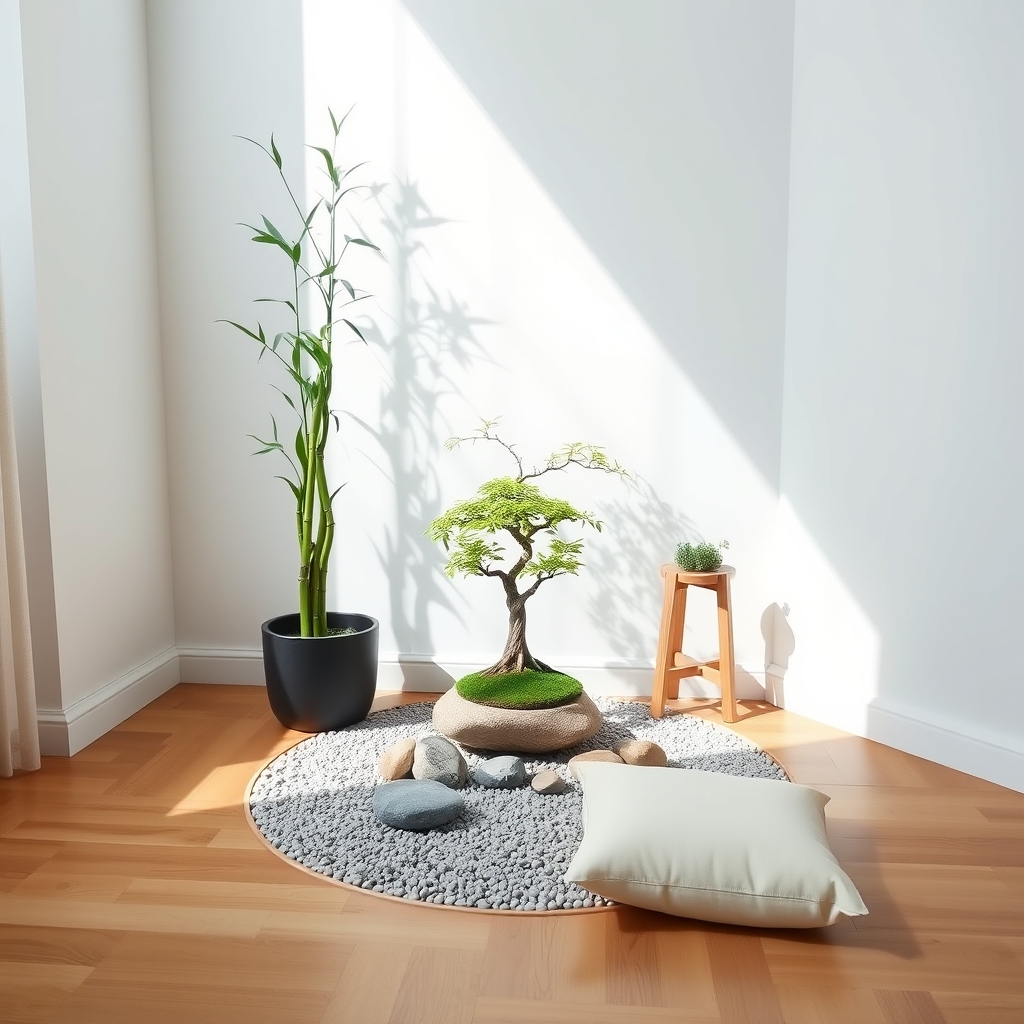
Japanese Zen Garden plant groupings create a minimalist, meditative atmosphere in the living room through deliberate, sparse arrangements.
Typically featuring 3-5 plants of varying heights, these groupings incorporate bamboo, bonsai trees, and low-growing moss or ferns. Plants are arranged asymmetrically but balanced, often set against light-colored stones or pale gravel.
The unique feature of this style lies in its intentional use of negative space (ma), where emptiness between plants is as important as the plants themselves.
These arrangements are frequently complemented by natural elements like river rocks or simple ceramic containers in earth tones, maintaining the characteristically peaceful Zen aesthetic.
Mediterranean Warmth: Terra Cotta and Trailing Plants
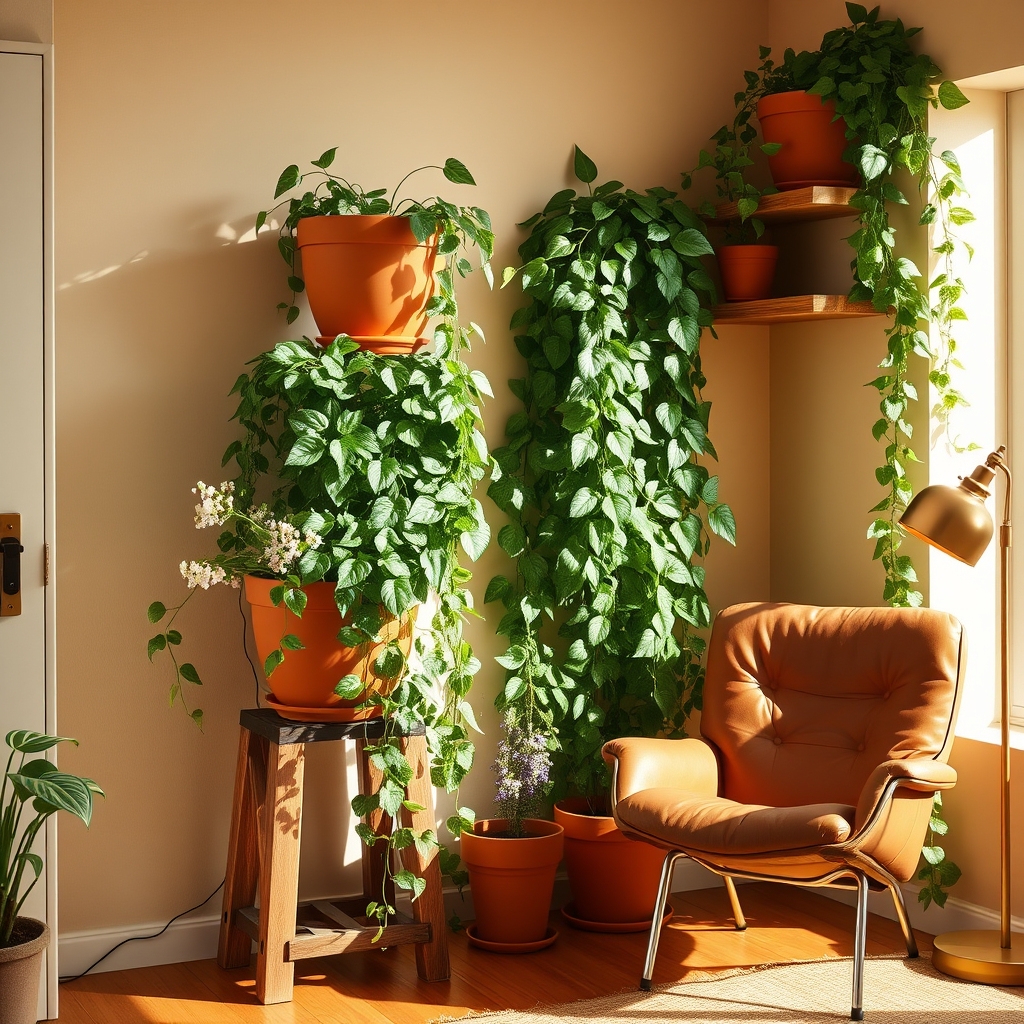
Mediterranean Warmth: Terra Cotta and Trailing Plants features a harmonious blend of warm-colored clay pots and cascading greenery that evokes the rustic charm of Mediterranean gardens.
Terra cotta containers, with their natural orange-brown hue and porous texture, provide an earthy backdrop for trailing plants like English ivy, pothos, or string of pearls. The plants spill gracefully over the pot edges, creating dynamic vertical interest and softening hard architectural lines.
This style typically incorporates multiple levels of plant placement, from floor-standing large pots to elevated shelving, allowing the trailing foliage to create natural curtains of green.
The combination’s distinctive characteristic lies in its ability to bring both warmth and movement to indoor spaces while maintaining a relaxed, sun-drenched Mediterranean aesthetic.
Mid-Century Modern: Architectural Plants and Wood Tones
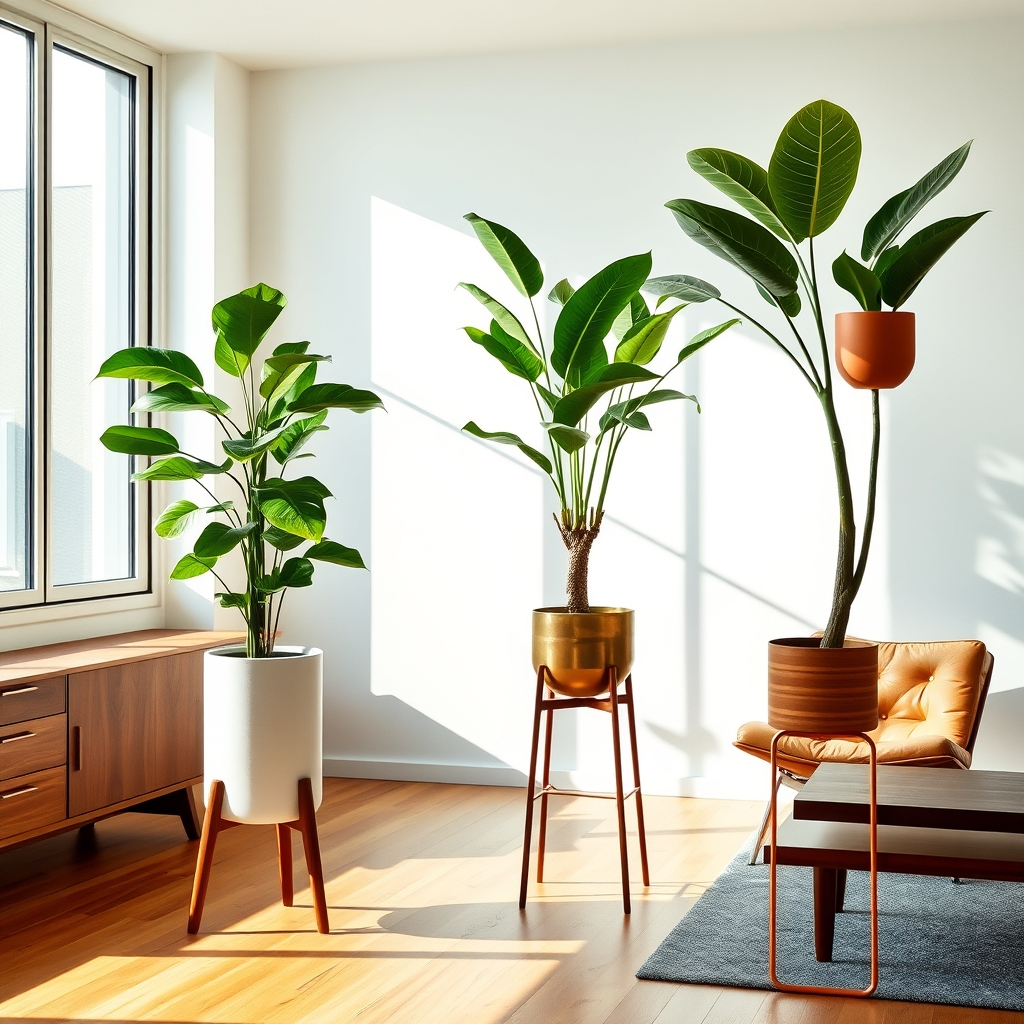
Mid-Century Modern plant styling pairs clean-lined architectural plants with warm wood tones to create a distinctly retro-modern aesthetic.
Snake plants, fiddle leaf figs, and split-leaf philodendrons feature prominently with their strong vertical lines and geometric shapes. These specimens are typically displayed in simple ceramic or wooden planters with tapered legs, often positioned on sleek wooden plant stands that echo the era’s furniture design.
The style emphasizes negative space and angular silhouettes, with plants strategically placed to complement rather than overwhelm the room’s minimalist architecture.
Natural materials like teak and walnut complement the organic forms, while brass or copper accents add characteristic mid-century metallic touches.
